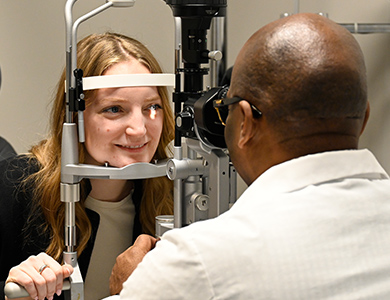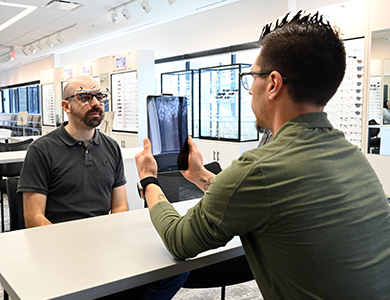
Low vision refers to reduced sight that cannot be fully corrected with eyeglasses, contact lenses, medication, or surgery. A person with low vision often has some useful sight; however, the vision impairment interferes with daily activities. Near activities such as reading or using a computer, as well as tasks such as cooking or writing, may be affected. For distance, blurred or distorted vision can hinder the ability to read signs, watch TV, recognize faces, or drive.
The goal of low vision rehabilitation is to help individuals gain and maintain the highest possible level of independence. A low vision evaluation will determine the best optical correction for distance and near vision. Additionally, the evaluation will identify which low vision devices might help compensate for vision loss. Low vision devices include optical aids such as handheld magnifiers, prism reading glasses, and handheld or spectacle-mounted telescopes. Electronic devices like closed-circuit televisions (CCTVs) or video magnifiers may assist with reading and writing tasks. Furthermore, computer programs that enlarge text or offer text-to-speech technology help some patients continue working or stay connected with family and friends.
If you are struggling with visual tasks, contact the University of Detroit Mercy Eye Institute for a low vision evaluation. We are equipped with the latest optical devices and electronic equipment. Early evaluation is more effective in developing an individualized plan to maintain your independence in daily activities.
Several eye diseases or conditions can cause low vision, and we will discuss the four most common causes of low vision below.
Macular Degeneration
Macular degeneration is a disorder that affects the retina, the light-sensitive tissue lining the inside of the eye. Within the retina, the macula, the area responsible for sharp central vision, deteriorates, causing blurred vision. This can create a blind spot in the central area of vision, leading to low vision.
There are two types of macular degeneration: non-exudative (dry form) and exudative (wet form). The dry form usually progresses slowly, while the wet form causes more rapid and severe vision loss due to abnormal blood vessels developing under the macula, which leak fluid and blood. The biggest risk factor for macular degeneration is age. Other risk factors include genetics, race, smoking, and high blood pressure.
Diabetic Retinopathy
Diabetic retinopathy is a complication of diabetes that affects the eyes. High blood sugar levels damage the blood vessels in the retina. At first, diabetic retinopathy may cause no symptoms or only mild vision problems. However, over time, it can severely damage the retina, leading to low vision. Anyone with diabetes can develop diabetic retinopathy, but the risk increases for those who have had diabetes for a long time, have poor control of blood sugar levels, high blood pressure, or cholesterol, or who smoke.
Cataracts
A cataract is a clouding of the lens in the eye that affects vision. This clouding can block light from reaching the retina at the back of the eye, resulting in a general loss of vision. In many cases, a cataract can be surgically removed. Cataract surgery has a high success rate in otherwise healthy eyes, but it is not always possible for people who also have other eye diseases. While the risk of cataracts increases with age, other risk factors include diabetes, smoking, alcohol use, and prolonged exposure to ultraviolet sunlight.
Glaucoma
Glaucoma is a disease that damages the eye’s optic nerve. Most commonly, this occurs when pressure builds up in the eye, permanently damaging the optic nerve. This may cause blurred vision or missing areas in the visual field (tunnel vision).
There are many risk factors for glaucoma, but those over 40 who have a family history of the condition should have regular eye exams to check for glaucoma. You may also be at increased risk if your eye doctor has noted high eye pressure, thin corneas, thinning of the optic nerve, or a history of eye injury. Additionally, certain health problems, such as diabetes, migraines, high blood pressure, or poor blood circulation, can be associated with glaucoma.

How to Prevent Low Vision from These Diseases
Even though age and genetics play a part, some common risk factors—diabetes, smoking, and high blood pressure—may be within your control. Here are the most important steps you can take to reduce your risk of low vision from macular degeneration, diabetic retinopathy, cataracts, and glaucoma:
- Be aware of your family's health history
- Get regular physicals
- Exercise regularly
- Eat a healthy diet
- Don’t smoke
- Visit your eye doctor for any changes in vision
- Protect your eyes from the sun
- Get your eyes checked at least every two years
By understanding the diseases that cause low vision, you can take steps now to reduce modifiable risk factors or get an early diagnosis to preserve your eyesight.










